FINOPS - money first

I have already discussed the topic of cloud costs in a previous Articles. We have shown you the different types of costs in the cloud and where and how you can save money. But how to manage it all and achieve efficient use of resources in a dynamic environment like the public cloud? The answer is... FinOps!
Jakub Procházka
What is FinOps
Most of you have probably already come across terms like DevOps, SecOps, DevSecOps and so on. But few have probably come across the terms FinOps or even CapOps. What do they mean? Why do we add the Ops suffix to the traditional disciplines of development, security, financial or capacity management?
FinOps or finance operations is a relatively young discipline that deals with, as the name suggests, the financial aspect of the operating environment in the public cloud. It is a methodology that aims to keep track of costs and provide overall insight into the operating environment. At the same time, it provides valuable information on how much individual services and applications cost us.
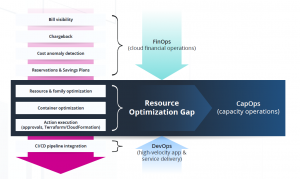
The relationship between FinOps, CapOps and DevOps is demonstrated in the image above. It shows that finance operations belongs to finance operations:
- insight into invoicing,
- chargeback,
- anomalous cost analysis,
- reservations and savings plans.
There is a partial gap between the already classic (and in recent years very popular) DevOps and the nowadays discussed FinOps, which is then trying to fill CapOps or capacity operationsi.e. managing the available resource capacity to match the actual needs of the operation.
Why should you care?
Clearly, the bigger the company, the harder it is to manage costs. In the context of the cloud, this is doubly true. The simple investment model of purchasing has morphed into a dynamic marketplace with constant changes in pricing, configurations and subscription volumes. It's not just about the resources themselves, but also about improving business processes and achieving company goals.
We are facing several challenges such as:
- difficulty in identifying the origin of costs,
- allocation of costs within the organisation (cost centres),
- unexpected fluctuations in costs,
- reliable cost reduction,
- taking advantage of various discounts and savings,
- uncertainty about whether the selected sources are optimal.
The benefits that a well-implemented FinOps brings us are:
- Insight - provides the company with insight into current costs and allocations.
- Cost Accountability - defines accountability by linking allocated resources and costs to existing projects and specific teams.
- Resource optimization - optimizes infrastructure utilization by changing, scaling, and removing existing resources.
- Governance - brings best practices to other future projects through applied policies and cost management strategies.

How to achieve your FinOps goals?
FinOps Lifecycle is continuously repeated in regular iterations. It can be divided into three successive phases:
- Inform
- Optimize
- Operate
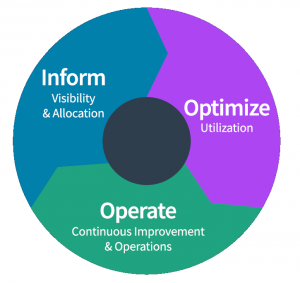
Inform
Start with the people. It's about communicating directly with individual teams and the business for creating shared responsibility for the resources consumed. The goal is to get accurate information about what the company is spending on, what they are making money on, and what efficiencies they are operating at.
Implement e.g. quality invoice analysis, decomposition of costs in different views across teams, cost centres or projects. Introduce appropriate budgets.
Optimize
Then process the information you gather, allowing your teams to improve your work processes, reveal detailed insight into operations and apply recommendations based on company goals.
Identify resource guzzlers, sources of provider billing fluctuations, outdated configurations, unused resources and untapped discounts, and many other opportunities for lower cost operations.
Operate
Finally... define and apply processes to provide continuity and structure. Add reliable technology. Part of finance operations there are tools and platforms that enable your teams to do their jobs more efficiently. Examples include a multi-cloud tool Densifywhich we have been using at ORBIT for our clients for several years.
Let the tools calculate the optimal instances, configurations, container sizing, composition of saving plans and reservations. Introduce automation of recommendations at the level of ordered services and deployment using dynamic infrastructure as a code.
How to start?
I probably won't surprise anyone with this, but the first thing you'll need is, again Plan. You can get significant help with adoption FinOps Foundationson whose website you will find a well-crafted framework. For an idea of what you can expect on this journey, you can take a look at the example of an adoption roadmap.
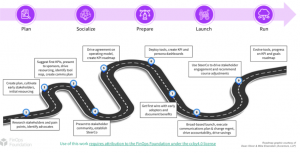
When adopting FinOps, it is important to keep in mind six basic principlesbased on the defined framework and you can't do without them:
- Teams need to work together.
- Decisions are driven by the business value of the cloud.
- Everyone takes responsibility for the resources they consume.
- FinOps reports should be accessible and well timed.
- The management team must be centralised.
- Think of variable pricing in the cloud as an advantage that works for you.
Who's gonna do it?
As stated in the first principle, teams must work together. We will need all of these roles for finance operations to work properly:
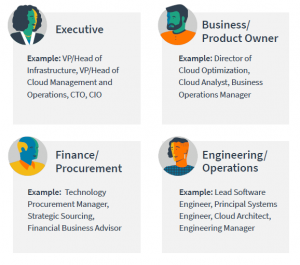
The following diagram shows FinOps model applicationwhere the FinOps team (sometimes referred to as cloud cost centre of excellence) works with the rest of the company to manage cloud strategy, governance and best practices so that the rest of the organization can benefit from moving applications to public clouds.
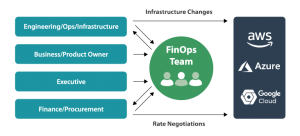
Tools that can help you
There are plenty of tools on the market to help with cost management. At ORBIT we use a very progressive Densify. This tool provides not only bill reader functionality, but more importantly advanced optimization recommendations based on measured metrics and using set policies and artificial intelligence recommends the ideal source for a given workload.
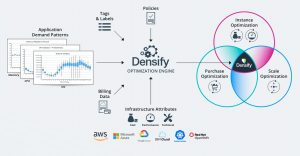
Each public cloud provider also offers its own more or less sophisticated tools that can help users with FinOps. I have already mentioned most of them in the previous Article on costs (e.g. AWS CloudWatch, Azure Advisor, tags, various calculators, etc.).
Where to next?
Are you interested in the idea finance operations and you want to know more? In that case I can recommend the site finops.orgoperated by FinOps Foundation falling under Linux Foundation. Or this an interesting article with almost an hour-long video in which colleagues from Densify discusses FinOps and tools in greater detail.
You can also find lots of other interesting cloud articles and tips in our cloud Encyclopedia.




